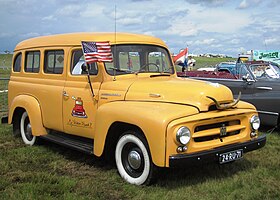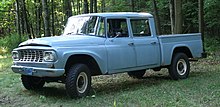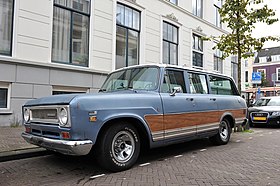
C/K is a series of trucks that was manufactured by General Motors from the 1960 to 2002 model years. Marketed by both the Chevrolet and GMC divisions, the C/K series encompassed a wide range of vehicles. While most commonly associated with pickup trucks, the model line also included chassis-cab trucks and medium-duty trucks and served as the basis for GM full-size SUVs. Through its entire production, the model line competed directly against the Ford F-Series and the Dodge D series.
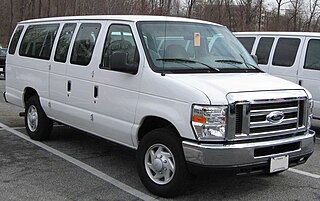
The Ford E-Series is a range of full-size vans manufactured and marketed by the Ford Motor Company. Introduced for model year 1961 as the replacement for the Ford F-Series panel van, the E-Series line is currently in its fourth generation.

The Ford Excursion is a heavy duty, full-sized SUV that was produced by Ford. The longest and heaviest SUV ever to enter mass production, the Excursion was marketed as a direct competitor of the 2500-series Chevrolet Suburban/GMC Yukon XL. Introduced on September 30, 1999 for the 2000 model year, a single generation was produced through the 2005 model year.

The International Harvester Company was an American manufacturer of agricultural and construction equipment, automobiles, commercial trucks, lawn and garden products, household equipment, and more. It was formed from the 1902 merger of McCormick Harvesting Machine Company and Deering Harvester Company and three smaller manufactures: Milwaukee; Plano; and Warder, Bushnell, and Glessner. In the 1980s all divisions were sold off except for International Trucks, which changed its parent company name to Navistar International. Its brands included McCormick, Deering, and later McCormick-Deering, as well as International. Along with the Farmall and Cub Cadet tractors, International was also known for the Scout and Travelall vehicle nameplates.
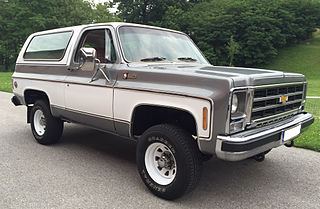
The Chevrolet K5 Blazer is a full-size sport-utility vehicle that was built by General Motors. GM's smallest full-size SUV, it is part of the Chevrolet C/K truck family. Introduced to the Chevrolet line for the 1969 model year, the K5 Blazer was replaced for 1995 by the Chevrolet Tahoe. The third generation was simply called "Chevrolet Blazer", without the K5 name. In 1970, GMC introduced its own model of the truck, called the Jimmy, which was discontinued in 1991 and replaced by the Yukon. The "Jimmy" name was chosen to reflect how GM may sound in a similar manner to how Jeep was thought to be a pronunciation of GP in the competing market. Both were short-wheelbase trucks and available with either rear- or four-wheel drive.

The International Harvester Scout is an off-road vehicle produced by International Harvester from 1961 to 1980. A precursor of more sophisticated SUVs to come, it was created as a competitor to the Jeep, and it initially featured a fold-down windshield. The Scout and second-generation Scout II were produced in Fort Wayne, Indiana, as two-door trucks with a removable hard top with options of a full-length roof, half-cab pickup, and/or soft top.

The Isuzu Faster is a pickup truck that was manufactured and marketed by Isuzu between 1972 and 2002 over three generations. The Faster was succeeded worldwide by Isuzu D-Max, except in North America.

The International R series is a model range of trucks that was manufactured by International Harvester. Introduced in 1953 as the replacement for the International L series, the model line marked the introduction of the IH "tractor" grille emblem on International road vehicles. Sharing a cab with its predecessor, the R-series marked the introduction of four-wheel drive vehicles and the wider use of diesel engines.

The International Metro Van, made by International Harvester, is a step van, also known as walk-in or multi-stop delivery truck. This vehicle type was one of the earlier, mass-produced forward control vehicles, once commonly used for milk or bakery delivery, as well as ambulance services, mobile offices, and radio transmitter vans. Typically, they were 1/2-, 3/4-, or 1-ton panel trucks that allowed the driver to stand or sit while driving the vehicle.

The Chevrolet Van or Chevy Van is a range of vans that was manufactured by General Motors from the 1964 to 1996 model years. Introduced as the successor for the rear-engine Corvair Corvan/Greenbrier, the model line also replaced the panel van configuration of the Chevrolet Suburban. The vehicle was sold both in passenger van and cargo van configurations as well as a cutaway van chassis that served as the basis for a variety of custom applications.

The seventh generation of the Ford F-Series is a range of trucks that was produced by Ford from the 1980 to 1986 model years. The first complete redesign of the F-Series since the 1965 model year, the seventh generation received a completely new chassis and body, distinguished by flatter body panels and a squarer grille. This generation marked several firsts for the model line, including the introduction of the Ford Blue Oval grille emblem, the introduction of a diesel engine to the model line, and a dashboard with a full set of instruments (optional). Conversely, this generation marked the end of the long-running F-100, the Ranger trim, and sealed-beam headlamps. This was also be the final generation of the F-Series produced with the traditional Flareside bed, using separate rear fenders and taillamps, steel sides, and an (optional) wooden floor.

The International Light Line pickups replaced the C-Series as International's Light Line range of pickup trucks in early 1969, for a shortened model year. The name started out as a simple continuation of the previous A-, B-, and C-series trucks. It was largely a rebodied version of its predecessors, with a square-rigged look very similar to the period Scout utility vehicle. The Travelall underwent parallel changes to the Light Line trucks. The light line of trucks was marked by a larger range of transmission and wheelbase options than any of its competitors, and in general the lineup aimed to maximize adaptability. The Light Line was also available as a bare chassis, for special purpose applications. Production ended partly replaced by new Scout Terra in late April 1975, as a hard-pressed International chose to focus on the Scout and on heavier machinery.
The International C series and its succeeding models is a series of pickup trucks that were built by International Harvester from 1961 to 1968. They succeeded the earlier B-series range.
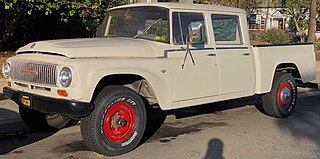
The Travelette is a sub-model of the International Harvester series of light-duty pickup trucks that was produced from 1957 to 1975. The Travelette was the first factory-production, 6 passenger, crew-cab pickup truck, made by any United States manufacturer.

The first generation of the C/K series is a range of trucks that was manufactured by General Motors from the 1960 to 1966 model years. Marketed by both the Chevrolet and GMC divisions, the C/K trucks replaced the Task Force generation of trucks. The first General Motors pickup trucks developed on a dedicated truck platform, the C/K series included pickup trucks, chassis-cab trucks, and medium/heavy commercial trucks.

The second generation of the C/K series is a range of trucks that was manufactured by General Motors. Marketed by both the Chevrolet and GMC divisions from the 1967 to 1972 model years, this generation was given the "Action Line" moniker by General Motors. As with its predecessor, the second generation C/K included full-size pickup trucks, chassis cab trucks, and medium-duty commercial trucks.

The third generation of the C/K series is a range of trucks that was manufactured by General Motors. Marketed under the Chevrolet and GMC brands from the 1973 to the 1991 model years, General Motors gave this generation of the model line the "Rounded Line" moniker. Produced across 18 model years, this series is the third-longest produced model of American pickup trucks.

The fourth generation of the C/K series is a range of trucks that was manufactured by General Motors. Marketed by the Chevrolet and GMC brands from the 1988 to the 2002 model years, this generation is the final version of the C/K model line. The C/K nomenclature itself became exclusive to Chevrolet, with the GMC division applying the GMC Sierra nameplate across its entire full-size pickup truck line. Internally codenamed the GMT400 platform, the fourth generation C/K was not given a word moniker. After its production, the model line would informally become known by the public as the "OBS", in reference to its GMT800 successor.

